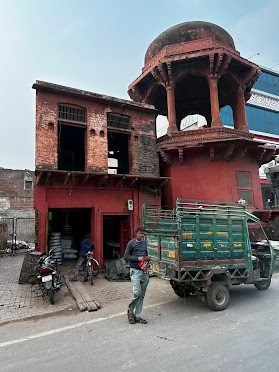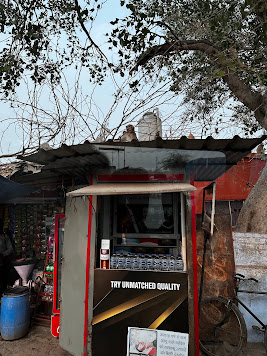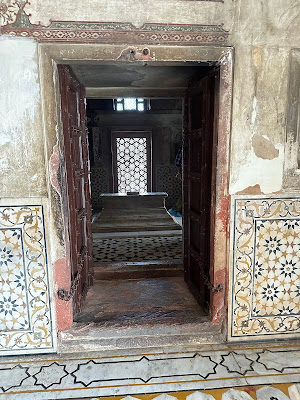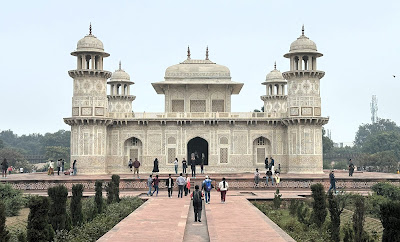December 27, 2024
Between the Agra Fort and our next destination, we passed a few interesting things on the street, including this man on horse back (left) who I think is Shivaji I, a 17th century Indidan ruler. The guy in the right peering in our van window is a bit scary, don't you think?We saw more monkeys on a roof and in a tree when we got to our destination the Itimad-ud-Daulah, locally known as the "Baby Taj."
Here is a drawing of the Itimad-ud-Daulah, and if you know what the Taj Mahal looks like, you can see what this is called the Baby Taj. Both are square tombs built on raised platforms and surrounded by elaborate walled gardens. While the Baby Taj looks colorful here, it was actually the first Mughal tomb to be built of white marble (previous monuments were built of red sandstone) and pre-dates the Taj Mahal by about 20 years. There is color in the mausoleum, but it comes from inlaid stonework and is more subtle than this.
Like the Taj Mahal, the walls surrounding the Baby Taj have four towering, elaborate, marble-embellished red stone gates.
At the heart of the building are the cenotaphs for Mirza Ghiyas Beg and his wife Asmat Begum. She was the first to die in 1621, and he died three months later in 1622. Theirs was a wonderful love story (They had a monogamous marriage and had seven children together), and I love that they now lie side-by-side in this beautiful building whose other nickname (besides Baby Taj) is "The Jewel Box."
The ceiling in that room has one of the most intricate designs I have ever seen. It would be amazing if it were paint, but as an inlaid design made of thousands of tiny pieces of stone, it is sensational.
The central room where the tombs are is surrounded by four oblong rooms, one on each sisde, and then four more square rooms on the corners. Those four corner rooms contain the tombs of other relatives. All of the rooms are connected by doorways. Windows appear to have lacy curtains, but that latticework is actually carved stone. Wow!
This gate looks out onto the Yamuna River:
One things that really impresses me about Islamic architecture and Mughal architecture specifically is the symmetry/balance of the buildings. Fold this photo in half and the two sides will match up exactly, down to the last carving.
Like the Taj Mahal, the walls surrounding the Baby Taj have four towering, elaborate, marble-embellished red stone gates.
And here she is. Isn't she a beauty?
The mausoleum is surrounded on all sides by lush gardens that are meant to symbolize the Islamic concept of paradise.
Once again we donned the blue booties provided by the site.
Viewed as a whole, the Baby Taj is graceful, ethereal, and almost looks like it could float. While not as large as some of the mausoleums we had previously seen, the Baby Taj is much richer in detailed precision and ornamentation.
From a distance, you could mistake the elaborate patterns on the walls for paint.
But a closer view shows that the walls and floors are richly decorated with inlaid semi-precious stones forming delicate vines, floral patterns, and geometric designs.
The central room where the tombs are is surrounded by four oblong rooms, one on each sisde, and then four more square rooms on the corners. Those four corner rooms contain the tombs of other relatives. All of the rooms are connected by doorways. Windows appear to have lacy curtains, but that latticework is actually carved stone. Wow!
There is a large open room within the gate where one can be protected from the elements and still enjoy the scenery. It is also a great place for a selfie.
One things that really impresses me about Islamic architecture and Mughal architecture specifically is the symmetry/balance of the buildings. Fold this photo in half and the two sides will match up exactly, down to the last carving.
Another thing I admire is their sense of "framing." So often I found myself wanting to include the edges of windows or doors in my photo. While the architects could not have had photography in mind, they must have been aware of the magical effect looking at a building through something else has.








































No comments:
Post a Comment